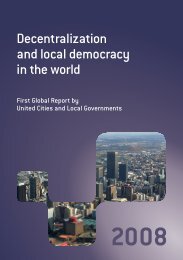Making Cities Resilient Report 2012
Making Cities Resilient Report 2012
Making Cities Resilient Report 2012
You also want an ePaper? Increase the reach of your titles
YUMPU automatically turns print PDFs into web optimized ePapers that Google loves.
and schools. In Bhubaneswar, drills are held at the city, ward, and community levels as well as in schools<br />
and colleges. Evacuation drills in Cape Town’s schools are monitored and supported by the city’s disaster<br />
risk management staff. While some cities have only recently begun holding drills and simulations, others<br />
have institutionalised the practice and hold them for a range of different activities. For example, Dubai<br />
recently conducted its first full simulation exercise for the municipality’s main building. The evacuation<br />
exercise will be carried at least once a year, particularly buildings that house critical facilities and<br />
operations such as the laboratories and plants. Dubai has also instituted evacuation plans for highoccupancy<br />
facilities such as shopping malls. In Saijo City, disaster drills have been carried out twice a<br />
year since 2007. Activities have included making sandbags, practicing carrying individuals on stretchers,<br />
gathering the population together, and communicating hazard events (48). Engaging the public in drills<br />
and simulations is a challenge. Mumbai reported that the number of citizens participating in their drill was<br />
disappointingly low. This highlights the importance of concurrent or preceding education and awareness<br />
campaigns, to increase public knowledge of the importance of emergency preparedness.<br />
Providing accessible emergency shelters is a key component of any evacuation strategy. These tend to<br />
double as schools or sports facilities during non-emergency periods. This is the case in Albay Province,<br />
and in Kisumu. Evacuation centres have been built next to three schools; another three are planned. Each<br />
facility includes water collection tanks and flood-resistant bore holes. Some cities maintain stockpiles of<br />
food, clothes, equipment and other relief supplies, for example in Baofeng and Makassar.<br />
Emergency response personnel<br />
It is common for cities to have dedicated teams or units responsible for the coordination and implementation<br />
of disaster response. These may be responsible for medical attention and basic life support, technical<br />
assistance, rapid damage assessment, or search and rescue. Response teams may be composed of<br />
paid personnel and trained volunteers. Colombo’s Municipal Council’s public assistance department<br />
provides post-disaster relief services in the first instance, supported with additional resources from other<br />
departments. In Makassar, the Rapid Response Team conducts quick assessment on behalf of the city’s<br />
Disaster Management Agency and is made up of staff from this agency and from city departments of social<br />
affairs, public health and public works.<br />
In Cairns, volunteer groups from Australia’s State Emergency Services are responsible for search and<br />
rescue in emergency situations, assisting injured persons, protecting the community from harm and<br />
promoting community preparedness. Their work is supported by the Local Disaster Management Group,<br />
which clarifies roles and responsibilities between local government, NGOs, the private sector and the<br />
regional council’s Disaster Management Unit.<br />
Monitoring technologies<br />
Some cities have developed sophisticated hazard monitoring and surveillance techniques for the particular<br />
hazards they face. Some focus on a single variable while others are able to handle multiple hazard<br />
parameters at the same time. Weather stations help monitor flood risk in Mumbai through 35 automatic<br />
weather stations that measure real time rainfall intensity and transmit data every 15 minutes. In addition,<br />
flow gauges have been installed upstream of the Mithi River to monitor water flow and, when needed, allow<br />
warnings downstream (25). In Ancona, monitoring focuses on landslide risk and an advanced Integrated<br />
Landslide Management System provides hourly monitoring of high-risk slopes, using geotechnical testing,<br />
rainfall, temperature, soil moisture, and other indicators of landslide risk (47). Some hazards do not<br />
require year-round monitoring because they are seasonal. In Baofeng, a leadership group responsible for<br />
meteorological monitoring is activated during the flood season from June to August each year (13). In Albay<br />
Province, monitoring technology has been integrated into a computer model called SimCLIM for climate<br />
variability, which assists with climate forecasting, early warning and land use planning. A few cities have<br />
integrated a community-based element into their monitoring techniques, for example in Ancona and in<br />
Albay Province, where communities undertake rainfall monitoring at district or ward level.<br />
62 | <strong>Making</strong> <strong>Cities</strong> <strong>Resilient</strong> <strong>Report</strong> <strong>2012</strong>

















